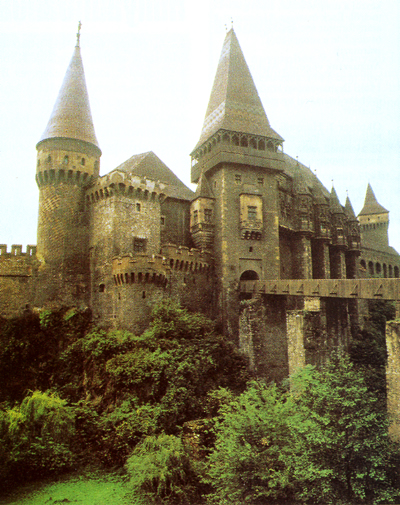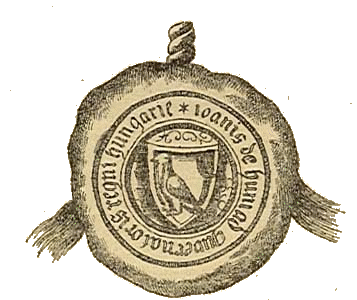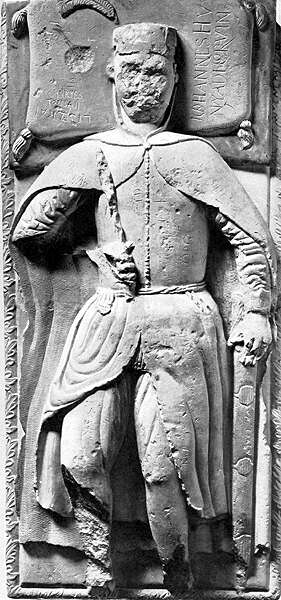<Back to Index>
- Biochemist Erwin Chargaff, 1905
- Novelist Charlotte Mary Yonge, 1823
- Regent - Governor of the Kingdom of Hungary John Hunyadi, 1407
PAGE SPONSOR
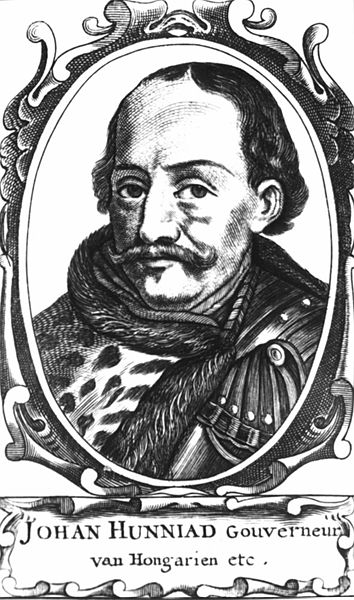
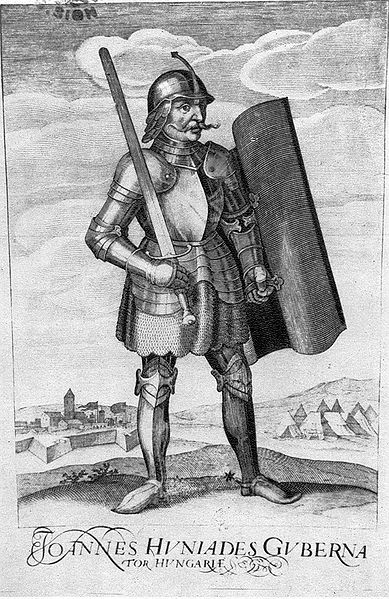
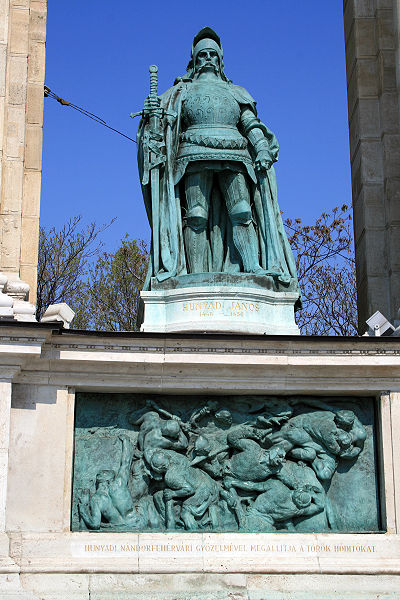
John Hunyadi (Hungarian: Hunyadi János, Medieval Latin: Ioannes Corvinus or Ioannes de Hunyad, Romanian: Iancu (Ioan) de Hunedoara, Croatian: Janko Hunjadi, Serbian: Сибињанин Јанко / Sibinjanin Janko, Slovak: Ján Huňady) (c. 1407 – 11 August 1456), nicknamed The White Knight was a general (1444 – 1446) and Regent - Governor (1446 – 1453) of the Kingdom of Hungary.
Hunyadi is widely celebrated as a successful and powerful generalissimo. He promoted a revision of dated military doctrine and was an outstanding and iconic military opponent of the Ottoman Empire. Hunyadi was, in a sweeping scope of European military history, the pre-eminent strategist and tactician of the 15th century in Christendom. He was also a Voivode of Transylvania (1440 – 1456), and father of the Hungarian king, Matthias Corvinus.
Hunyadi's military genius, prowess and wherewithal to prosecute preventive and aggressive crusading warfare policies welded together many Christian nationalities against the onslaught of the vastly numerically superior Ottoman Muslim forces. Hunyadi's leadership achieved a state of integrity, stalemate and détente for the Hungarian Kingdom and the many European states that lay to its periphery.
Hunyadi's aim to re-organize the military forces of Hungary from strictly a feudal based aristocratic levy into
an efficient and professional standing army would bring reform to
European military components in a 'post - Roman' European war making
society. These reforms were further developed by his successor and son
King Matthias Corvinus who took them to their ultimate culmination with the Black Army of Hungary. Hunyadi is often considered the bellwether of the European "post - Roman" professional "Standing Army". He is renowned as one of the greatest Medieval field commanders of all time: His victory over Mehmed II at the Siege of Nándorfehérvár (now Belgrade) in 1456 against overpowering odds is regarded as a seminal piece of European military history. He was awarded the title Athleta Christi (Champion of Christ) by Pope Pius II. The Hunyadi family were Hungarian noble family in the medieval Kingdom of Hungary, of Wallachian (Romanian) origin according to the majority of sources. Hunyadi was named Valachus or Balachus ("the Wallachian") in some contemporary texts. There are also authors suggesting a possible Slavic origin, with other sources suggesting a possible Tatar - Cuman descendance. However, according to Hugh Seton - Watson, "both Hunyadi and his son considered themselves Hungarians". According to other options, John Hunyadi came from a modest Romanian noble family from Hațeg. Others simply refer to the obscurity surrounding the year of birth and parentage. The Hunyadis were first recorded in a royal charter of 1409 in which Sigismund of Luxembourg, then King of Hungary, granted Vojk the Hunyad Castle (in contemporary Hungarian: Hunyadvár, later Vajdahunyad, in present day Romanian: Hunedoara) and its estates for his distinction in the wars against the Ottomans. Vojk (or Vajk / Vayk) - Hunyadi's father - was described as being Vlach (an exonym and sometime endonym for Romanian) descent by medieval chroniclers and modern historians. He was a noble Knyaz from Wallachia and was the son of "Şerb" (also spelled Serban, Sorb, Serbe or Sorbe), or a Vlach Knyaz from the Banate of Szörény (Severin), Kingdom of Hungary.
There are varying opinions as to Şerb's ancestry. From one point of
view he had supposedly Tatar - Cuman origin, because the second part of
his name is derived from a Cuman dignity name ('Bâg'- prince) and
'Sor' means 'Calamity' in Tatar - Turkic. Additionally, 'Sor' was an Altaic people in that period as well. "Şerb" became Catholic and Hungarian in culture. According to medieval sources, Şerb had three sons: Hunyadi's father Vojk (a Hungarian pagan name, or a properly Vlach name, or even a Turkic or Slavic one),Magos (Mogoş, also Mogos, meaning "tall" in Hungarian), and Radu(l) or Radol (a Romanian name). According
to some linguists, his son's name (Vayk) was likely originated from the
Turkic 'Bayk, Bayq', what was used till the 18th century by Tatars. A theory developed at the end of the 19th century that Şerb was originally from Serbia. Vojk took the family name of Hunyadi in 1409 when he received the estate around the Hunyad Castle from
Sigismund and was ennobled as count of Hunyad. There are theories about
his great - grandfather, researchers suggest that he was probably called Costea. While the family's name and ascent to comital rank of Count of Hunyad were established only by Sigismund granting the title; the lack of evidence for royal descent gave
rise to various legends and scholarly constructions about the origins
of the Hunyadis. This is especially true of Hunyadi's son Matthias
Corvinus and his origin has also been disputed in modern times. Matthias Corvinus' court historian Antonio Bonfini flattered his king by tracing the family's ancestry to the Roman gens Corvina, or Valeriana, while adding: "for this man was indeed born of a Romanian father and a Hungarian mother" A contemporary Hungarian historian Johannes de Thurocz, similarly flattering his king, wrote in the Chronicle of the Hungarians (Chronica Hungarorum) that the Hunyadi family was of Hunnic origin, even calling Matthias Corvinus the "Second Attila". The 16th century Saxon historian Gáspár Heltai made Hunyadi the illegitimate son of king Sigismund and the young noble Erzsébet Morzsinay. The epithet Corvinus (referring to the raven) was first used by Antonio Bonfini the biographer of his son Matthias Corvinus, but is also applied to Hunyadi. It is linked to the legend documented by Gáspár Heltai. The legend said that Hunyadi was the illegitimate son of Hungarian King Sigismund of Luxembourg, and
that Vojk was a faithful soldier of his father for two decades. After
the death of his wife, King Sigismund met Elizabeth Morzsinai, a virgin
noblewoman, and fell in love. In the morning, the king gave a royal ring
to the lady, promising her that he would take care of the son. After
the boy was born, the family set off to Buda to
the palace of Sigismund. During the trip, they took a rest, and baby
Hunyadi started crying. Elizabeth gave him the ring to make him quiet,
whereupon a rook stole the ring. Elizabeth's brother took his bow and
arrow and shot the rook, whereupon, as if by a miracle, the rook did not
die, and the ring was recovered. Arriving at the royal court in Buda,
Sigismund filled the baby's cradle with precious stones. Other versions
of the legend state that it was the child Hunyadi himself, about 6 years
old, who shot the arrow. The
legend may have some basis in fact, as his presumed father, Vojk, had
never before had a coat of arms depicting a raven, and suddenly he
changed it for some reason. Moreover the Wallachian coat of arms (which
changed its appearance through the Early Modern Age) depicts a raven - like bird (actually a black aquila chrysaëtos) holding a cross in its beak. The
family of Vojk received the estates of Hunyad, and Hunyadi's education
was funded by the king. The part of the legend that is most questioned
is not the raven and the events surrounding Hunyadi, but the parentage
by Sigismund. The main counterargument is
that Hunyadi was not able to become king of Hungary because he was not
considered of royal blood. It is argued that Hunyadi, his wife
Elizabeth, and their son Matthias invented and/or promoted the legend in
order to allow Hunyadi's son to become king.
Hunyadi's mother was Elizabeth Morzsinay (Hungarian: Erzsébet Morzsinay, Romanian: Elisabeta Morşina or Elisabeta Mărgineanu), a lady of the lesser nobility from Káránsebes (today: Caransebeş), Krassó - Szörény county, Kingdom of Hungary. According to primary sources she was the daughter of a Romanian lesser noble from Hunyad (Hunedoara), Transylvania, Kingdom of Hungary. Some modern writers suggest she was ethnic Hungarian while
others note that her family (also known as the Demsusi Muzsina family)
was a family of Romanians ennobled in the second half of the 15th
century. Since
she was a noble her religion was Roman Catholicism. Ortodox people were
not allowed to be noble in the Kingdom of Hungary at least not after
the arrival of Anjou kings. John Hunyadi had two children, Ladislaus and Matthias Corvinus. Ladislaus felt victim to the struggle between Hungary's various barons and its Habsburg king, Ladislaus the Posthumous (also king of Bohemia), in the years after the death of Hunyadi. After the assassination of Ulrich II of Celje,
the king felt threatened by Ladislaus. The king planned to eliminate
him by inviting him to Buda. Suspecting no evil, Ladislaus accompanied
the King to Buda, but on arriving there was arrested on a charge of
plotting against the King, condemned to death without the observance of
any legal formalities, and beheaded on 16 March 1457. His
brother, Matthias, was also inveigled to Buda by the enemies of his
house, and, on the pretext of being concerned in a purely imaginary conspiracy against the King, was condemned to decapitation, but was spared on account of his youth. In November 1457, the King died. Matthias was taken hostage by George of Poděbrady, governor of Bohemia,
a friend of the Hunyadis who aimed to raise a national king to the
Magyar throne. Poděbrady treated Matthias hospitably and affianced him
with his daughter Catherine, but still detained him, for safety's sake,
in Prague, even after a Magyar deputation had hastened thither to offer
the youth the crown. Matthias took advantage of the memory left by his
father's deed, and by the general population's dislike of foreign
candidates; most of the barons, furthermore, considered that the young
scholar would be a weak monarch in their hands. An influential section
of the magnates, headed by the Palatine Ladislaus Garai and by Nicholas of Ilok, voivode of
Transylvania, who had been concerned in the judicial murder of
Matthias's brother Ladislaus, and hated the Hunyadis as semi - foreign
upstarts, were fiercely opposed to Matthias's election; however, they
were not strong enough to resist against Matthias's uncle Mihály Szilágyi and his 15,000 veterans. On 20 January 1458, Matthias was elected king by the Diet.
It was the first time in the medieval Hungarian kingdom that a member
of the nobility, without dynastic ancestry and relationship, mounted the
royal throne. While still a young enterprising man, Hunyadi entered the retinue of Sigismund,
who appreciated his qualities but was also the King's creditor on
several occasions. A document describing a loan agreement of 1.200 gold
florins, dated from 1434 refers to him "János the Wallachian" (John the Wallachian). He accompanied the monarch to Frankfurt in Sigismund's quest for the Imperial crown in 1410, took an active part in the Hussite Wars in 1420, and in 1437 was sent south to successfully raise the Turkish siege of Semendria. The young knight served many powerful magnates and strategists of Sigismund, including Stefan Lazarević and Philippo Scolari. In Milan he made the acquaintance of the condottiere (mercenary captain) Francesco Sforza and studied the new military art of Italy. Later
he received numerous landed estates and a privileged position in the
royal council of Hungary. His star was soon in the ascendant and in 1438 King Albert found Hunyadi promoted to Ban of Severin that lay south of the defensible southern frontiers of Hungary; the Carpathians and the Drava / Sava / Danube complex, a province subject to constant Ottoman harassment. On
the untimely death of Albert in 1439, Hunyadi was of the volition that
Hungary was best served by a warrior king and lent his support to the
candidature of young King of Poland Władysław III of Varna in 1440, and thus came into collision with the powerful magnate Ulrich II of Celje, the chief proponent of Albert's widow Elisabeth of Bohemia (1409 – 1442) and her infant son, Ladislaus Posthumus of Bohemia and Hungary.
Featuring prominently in the brief ensuing civil war, Władysław III's
side was thus reinforced by Hunyadi's noticeable military abilities, and
was rewarded by Władysław with the captaincy of the fortress of Belgrade, a latter dignity that he shared with Mihály Újlaki. He
became the king's trusted adviser and most highly regarded soldier, and
was put in charge of military operations against the Ottomans. The king
recognized Hunyadi's merits by granting him estates in Eastern Hungary.
Hunyadi became the greatest landowner in Hungarian history. At the peak
of his career he could call himself master of 2.3 million hectares of land, 28 castles, 57 towns and about 1,000 villages. Unlike
most of his contemporaries, Hunyadi did not use his great revenues or
the military and political weight of his thousands of retainers simply
for his personal aggrandizement; for many years, he bore a large share
of the cost of fighting the Ottomans. The
main frame of the conflict with the Turks now resided in his
jurisdiction and Hunyadi soon showed and displayed extraordinary
capacity in marshalling its defenses with the limited resources at his
disposal. In 1441 he scored a pitched battle victory at Semendria over Ishak Bey. The following year, not far from Nagyszeben in
Transylvania he annihilated an invasion force of Ottomans that offered
stern battle with an immense host, and recovered for Hungary the suzerainty of Wallachia. In February 1450, he signed an alliance treaty with Bogdan II of Moldavia. In July 1442, an undaunted and intrepid Hunyadi proceeded to march against the enemy with 15,000 Hungarian and Szekler irregulars against a massive formation of a third Turkish invasion force reinforced
by the choicest of Ottoman military numbering 80,000 in Wallachia sent
in retaliation for previous defeats. Hunyadi's engagement at the Iron Gates is one of Hungary's more celebrated victories, Hunyadi's maneuvers of infantry, cavalry and war wagons performed
superbly to the astonishment of the Turkish commander Sehabbedin, who
was astounded by the smallness of the Magyar army. These victories made Hunyadi a prominent enemy of the Ottomans and renowned throughout Christendom, and was a prime motivator to undertake in 1443, along with King Władysław, the famous expedition known as the long campaign. Hunyadi, at the head of the vanguard, crossed the Balkans through the Gate of Trajan, captured Niš, defeated three Turkish pashas, and, after taking Sofia, united with the royal army and defeated Sultan Murad II at Snaim (Kustinitza).
The impatience of the king and the severity of the winter then
compelled him (February 1444) to return home, but not before he had
utterly broken the Sultan's power in Bosnia, Herzegovina, Serbia, Bulgaria, and Albania. No sooner had he regained Hungary than he received tempting offers from Pope Eugene IV, represented by the Legate Julian Cesarini, from Đurađ Branković, despot of Serbia, and George Kastrioti Skanderbeg,
prince of Albania, to resume the war and realize his ideal of driving
the Ottomans from Europe. All the preparations had been made when
Murad's envoys arrived in the royal camp at Szeged and offered a ten years' truce on
advantageous terms. Branković bribed Hunyadi – he gave him his vast
estates in Hungary – to support the acceptance of the peace. Cardinal Julian Cesarini found
a traitorous solution. The king swore that he would never give up the
crusade, so all future peace and oath was automatically invalid. After
this Hungary accepted the Sultan's offer and Hunyadi in Władysław's name
swore on the Gospels to observe them. Two days later Cesarini received tidings that a fleet of Venetian galleys had set off for the Bosporus to prevent Murad (who, crushed by his recent disasters, had retired to Anatolia)
from recrossing into Europe, and the cardinal reminded the King that he
had sworn to cooperate by land if the western powers attacked the
Ottomans by sea. In July the Hungarian army recrossed the frontier and
advanced towards the Black Sea coast in order to march to Constantinople escorted by the galleys. Đurađ Branković,
however, fearful of the sultan's vengeance in case of disaster,
privately informed Murad of the advance of the Christian host, and
prevented Kastrioti from
joining it. On reaching Varna, the Hungarians found that the Venetian
galleys had failed to prevent the transit of the Sultan - indeed, the Genoese transported
the Sultan's army (and received, according to legend, one gold piece
for each soldier shipped over). Hunyadi, on 10 November 1444, confronted
the Ottomans with less than half the Hungarian forces. Nevertheless,
victory was still possible in the Battle of Varna as Hunyadi with his superb military skills managed to route both flanks of the Sultan's army. At this point, however, king Władysław,
who up to that point had remained in the background and relinquished
full leadership to Hunyadi, assumed command and with his bodyguards
carried out an all-out attack on the elite troops of the Sultan, the Janissaries.
The Janissaries readily massacred the king's men, also killing the
king, exhibited his head on a pole. The king's death caused disarray in
the Hungarian army, which was subsequently routed by the Ottomans;
Hunyadi himself narrowly escaped. On his way home, Vlad II Dracul of Wallachia imprisoned Hunyadi; only the threats of the palatine of Hungary brought the voivode, theoretically an ally of Hunyadi against the Ottomans, to release him. In 1448 he received a golden chain and the title of Prince from Pope Nicholas V, and immediately afterwards resumed the war with the Ottomans. He lost the two day Second Battle of Kosovo (7 – 10 October 1448), owing to the treachery of Dan II of Wallachia, then pretender to the throne, and of his old rival Branković, who intercepted Hunyadi's planned Albanian reinforcements led by George Kastrioti, preventing them from ever reaching the battle. Branković also imprisoned Hunyadi for a time in the dungeons of the fortress of Smederevo,
but he was ransomed by his countrymen and, after resolving his
differences with his powerful and numerous political enemies in Hungary,
led a punitive expedition against the Serbian prince, who was forced to
accept harsh terms of peace. In 1450 Hunyadi went to Pozsony to negotiate with Holy Roman Emperor Frederick III the terms of the surrender of Ladislaus V, but no agreement could be reached. Several of John Hunyadi's enemies, including Ulrich II of Celje, accused him of conspiracy to
overthrow the King. In order to defuse the increasingly volatile
domestic situation, he relinquished his regency and the title of regent. On his return to Hungary at the beginning of 1453, Ladislaus named him count of Beszterce and Captain General of the kingdom. The king also expanded his coat of arms with the so-called Beszterce Lions. Meanwhile, the Ottoman issue had again become acute, and, after the fall of Constantinople in 1453, it seemed natural that Sultan Mehmed II was
rallying his resources in order to subjugate Hungary. His immediate
objective was Nándorfehérvár (today Belgrade).
Nándorfehérvár was a major castle - fortress, and a
gate keeper of south Hungary. The fall of this stronghold would have
opened a clear way to the heart of Central Europe. Hunyadi arrived at the siege of Nándorfehérvár at
the end of 1455, after settling differences with his domestic enemies.
At his own expense, he restocked the supplies and arms of the fortress,
leaving in it a strong garrison under the command of his brother - in - law Mihály Szilágyi and his own eldest son László Hunyadi. He proceeded to form a relief army, and assembled a fleet of two hundred ships. His main ally was the Franciscan friar, Giovanni da Capistrano (known today as St. John of Capistrano), whose fiery oratory drew a large crusade made up mostly of peasants. Although relatively ill-armed (most were armed with farm equipment, such as scythes and pitchforks) they flocked to Hunyadi and his small corps of seasoned mercenaries and cavalry. On 14 July 1456 the flotilla assembled
by Hunyadi destroyed the Ottoman fleet. On 21 July, Szilágyi's
forces in the fortress repulsed a fierce assault by the Rumelian army,
and Hunyadi pursued the retreating Ottoman forces into their camp,
taking advantage of the Turkish army's confused flight from the city.
After fierce but brief fighting, the camp was captured, and Mehmet
lifted the siege and returned to Istanbul.
A 70 year period of relative peace on Hungary's southeastern border
began with his flight. However, plague broke out in Hunyadi's camp three
weeks after the lifting of the siege, and he died August 11. On his
deathbed Hunyadi said Defend,
my friends, Christendom and Hungary from all enemies... Do not quarrel
among yourselves. If you should waste your energies in altercations, you
will seal your own fate as well as dig the grave of our country.. He is buried in the Roman Catholic Cathedral of Gyulafehérvár (now: Alba Iulia)
next to his younger brother, John. Sultan Mehmet II paid him
tribute:"Although he was my enemy I feel grief over his death, because
the world has never seen such a man." Pope Callixtus III ordered
the bells of every European church to be rung every day at noon, as a
call for believers to pray for the defenders of the city. The practice of Noon bell is traditionally attributed to the international conmemoration of the Belgrade victory and to the order of Pope Callixtus III. Along with his son Matthias Corvinus, Hunyadi is considered a Hungarian national hero and praised as its defender against the Ottoman threat. He
was born in and had a career in the Kingdom of Hungary, Hunyadi was a
member of the Hungarian aristocracy and a subject of the Hungarian crown. His whole life was dedicated to the Hungarian and Christian cause; he married a Hungarian noblewoman, Erzsébet Szilágyi; and he reared his children as Magyars. He no doubt was born in the Catholic faith,
which his father probably had already professed. He has not only become
member of the Hungarian nobility but has also risen according to their deserts to the highest positions in the land. John Hunyadi is mentioned in Szózat, a poem which is considered a "second anthem" of Hungary. Romanian historiography gives Hunyadi a place of importance in the history of Romania too. He is remembered in Romania as a national hero mostly due to his Romanian origin and his role as Voivode of Transylvania (a region at the time part of the Kingdom of Hungary now part of Romania). Hunyadi was also responsible for establishing the careers of both Stephen III of Moldavia and the controversial Vlad III of Wallachia. Pope Pius II writes that Hunyadi did not increase so much the glory of the Hungarians, but especially the glory of the Romanians among whom he was born. The French writer and diplomat Philippe de Commines described Hunyadi as a
very valiant gentleman, called the White Knight of Wallachia, a person
of great honour and prudence, who for a long time had governed the
kingdom of Hungary, and had gained several battles over the Turks. Hunyadi
was "recognised as being Hungarian..." and "frequently called Ugrin
Janko, 'Janko the Hungarian'" in the Serbian and Croatian societies of
the 15th century, while another bugarštica makes him of Serbian origin. He is also portrayed as an ardent supporter of the Catholicization of Orthdox peoples. In Bulgarian folklore, the memory of Hunyadi was preserved in the epic song hero character of Yankul(a) Voivoda, along with Sekula Detentse, a fictitious hero perhaps inspired by Hunyadi's nephew, János Székely. Nicolaus Olahus was the nephew of John Hunyadi. Among Hunyadi's noted qualities, is his regional primacy in recognizing the insufficiency and unreliability of the feudal levies, instead regularly employing large professional armies. His notable contribution to the development of the science of European warfare included the emphasis on tactics and strategy in place of over - reliance on frontal assaults and mêlées. His diplomatic, strategic, and tactical skills allowed him to serve his country well. After his death, Pope Callixtus III stated
that "the light of the world has passed away", considering his defense
of Christendom against the Ottoman threat. The same pope ordered the noon bell to be rung for the memory of Hunyadi's victory in siege of Belgrade, and to mark the resistance to Islamic progression inside Europe.
In 1432, Hunyadi married Erzsébet Szilágyi (c. 1410 - 1483), a Hungarian noblewoman, also of high rank (Szilágy being the name of a county overlapping with present day Sălaj County).
At the diet which met in February 1445 a provisional government consisting of five Captain Generals was formed, with Hunyadi receiving Transylvania and four counties bordering on the Tisza, called the Partium or Körösvidék, to rule. As the anarchy resulting from the division became unmanageable, Hunyadi was elected regent of Hungary (Regni Gubernator) on 5 June 1446 in the name of Ladislaus V and given the powers of a regent. His first act as regent was to proceed against the German king Frederick III, who refused to release Ladislaus V. After ravaging Styria, Carinthia, and Carniola and threatening Vienna, Hunyadi's difficulties elsewhere compelled him to make a truce with Frederick for two years.
